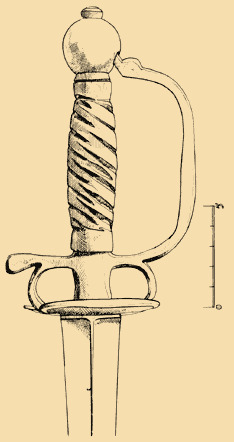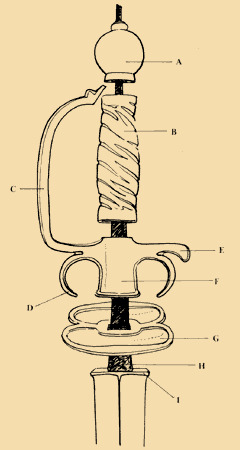Extract of the article, “The infantry sword at the end of the seventeenth century”, by Michel Pétard, in the Gazette des Armes (N° 102, February 1982), reprinted with the magazine’s permission.
The sword’s morphology
The hilt is of the type called “à la mousquetaire”, with the guard in the form of a coquille with the pas-d’âne departing from the écusson. The blade, judging from the specimens I was able to study, measures between 26 and 28 inches. It has the form of a lozenge and therefore has two cutting edges.

Fabrication
 The entire hilt is made of brass and composed of four distinct pieces: the coquille, the guarding branch accompanied by the quillon and the pas-d’âne, the tang and, finally, the pommel (the latter always being hollow and realized either as one solid nucleus or else in two halves, as is the case for the tang).
The entire hilt is made of brass and composed of four distinct pieces: the coquille, the guarding branch accompanied by the quillon and the pas-d’âne, the tang and, finally, the pommel (the latter always being hollow and realized either as one solid nucleus or else in two halves, as is the case for the tang).
It should be pointed out right away that the assembly was rather rustic and the process of refining and polishing didn’t succeed in hiding the multiple defects from a very mediocre foundry!
As for the blade, it was probably produced at St Etienne en Forez, a foundry that did not enjoy a great reputation when it came to bladed weapons!
As for the scabbard, it was traditionally in wood covered in calfskin with a covered hook and brass garnishing.
The advantages of the infantry sword
… were first and foremost economic, small dimensions and very easy to care for. We have seen that the fabrication is made easy by the nature of the raw materials, which explains the low cost of a sword carried by the poorest colonels.
Its disadvantages
This sword remains a cumbersome and ungainly object; in a word, useless. In fact, this very problem was brought up by numerous corps leaders toward 1710, who considered eliminating this weapon that encumbered their soldiers, who were only effective with a rifle. Louvois never accepted this rather sensible idea under the pretext that the sword was the only object that distinguished the soldier from the peasant.
Nomenclature (in French)

A. Le pommeau et son bouton de rivure ; B. La fusée ; C. La branche de garde et son crochet l'assurant au pommeau ; D. Le pas d'âne ; E. Le quillon ; F. L'écusson ; G. La coquille ; H. La soie sur laquelle s'ajuste la monture ; I. Le talon. |
